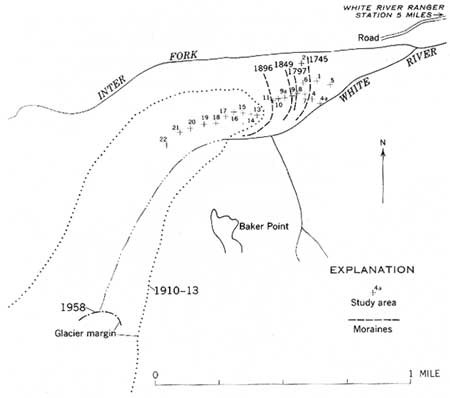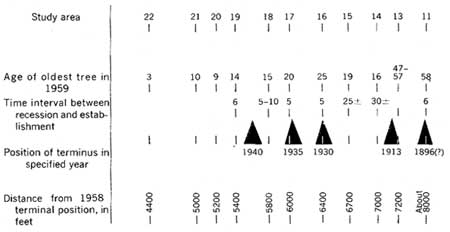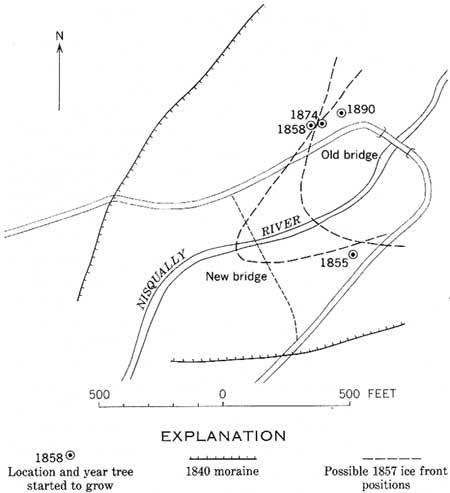
|
Geological Survey Professional Paper 387-A
Botanical Evidence of the Modern History of Nisqually Glacier Washington |
MODERN HISTORY OF NISQUALLY GLACIER
(continued)
RECESSION BETWEEN 1840 AND 1900
LOCATION AND DESCRIPTION OF MORAINE
The 1840 moraine of Nisqually Glacier is 10 to 20 feet high, 25 to 50 feet wide, and is composed of angular blocks. The moraine is treeless at many places and thus forms an open lane between the old forest and the young forest.
Within the bounds of the 1840 moraine 22 areas were studied. The authors took cores from 104 trees and counted rings on 32 stumps. The location of the oldest trees in some of these areas is shown on the map in figure 6; the trees and the moraine in the vicinity of the highway were located by plane table. Other trees and moraines were located photogrammetrically from aerial photographs made in 1956.
The young forest within the bounds of the end moraine on each side of the valley occupies a crude wedge-shaped area, which narrows upstream (fig. 7). The forest extends approximately 1,000 feet upstream from the terminal moraine. The forest is only about 100 feet wide at an altitude of about 400 feet above Nisqually River in the vicinity of the stream that forms Tato Falls on the northwest side of Nisqually River valley. The forest is somewhat wider on the southeast side of the valley in the vicinity of the stream opposite Tato Falls; its upper limit is about 600 feet in altitude above Nisqually River.

|
| FIGURE 7—Nisqually Glacier is partly covered with snow at the head of Nisqually River valley near top of photograph; the 1840 moraine is indicated by a dashed line. Larger trees upslope from the line comprise the old forest; smaller trees downslope comprise the young forest. A new bridge (under contruction) is visible in center; the older bridge is hidden by a fir tree in right foreground. July 9, 1959. |
The trees in this forest consist of western white pine, western hemlock, Douglas-fr, Pacific silver fir, noble fir, and Alaska-cedar. They range in diameter from 0.5 to 2.5 feet, hemlock and cedar trees are smaller than the others.
In contrast to the old forest, large fallen logs are not present in the young forest (figs. 3 and 4). Many trees have fallen, but trunks are smaller in diameter than those of the standing trees; thus the fallen logs are assumed to be of the same age or younger than the standing trees. The forest floor consists predominantly of large boulders only partly overgrown by mosses and lichens. Little humus has accumulated, and it consists primarily of decayed litter. Almost no rotten wood is found in the humus indicating that too little time has elapsed since the moraine was formed for trees to grow, die, and decay. No charcoal is found in the soil profile from which a preexisting forest could be inferred.
TIME INTERVAL BETWEEN CESSATION OF ADVANCE AND ESTABLISHMENT OF SEEDLINGS
In order to determine the time interval between the accumulation and stabilization of superglacial debris during the final stages of advance of Nisqually Glacier, trees and seedlings were sampled at locations of known positions of the glacier in the past. Only a few seedlings were found immediately below the present position of Nisqually Glacier. Trees are growing, however, at places that are near older dated locations of the terminus of the glacier, and some seedlings are present on surfaces that are known to have been covered with ice during certain recent years. These trees started to grow from 2 to 13 years after ice was known to have covered the site. The dated positions of the ice front and year that the trees started to grow are shown in figure 6. Trees were sampled along a transect extending from Tato Falls about 350 feet northwest to a point at the edge of the dense forest. The location of this transect and of other sampled trees are shown on figure 8.
On the basis of data collected only in Nisqually River valley, the time interval between stabilization of the moraine and establishment of seedlings averages about 5 years. However, an analysis of tree ages on surfaces downvalley from Emmons Glacier reveals that the time interval may be shorter. North of the stream flowing from Baker Point (figs. 9 and 10), two nearly bare moraines are located in the approximate position of Emmons Glacier in 1913, as represented on the quadrangle nnap of Mount Raiunier National Park, 1955. On the moraine farther downvalley, trees started to grow between 1901 and 1904. On the other moraine, approximately 100 to 200 feet upvalley, the oldest tree sampled started to grow in 1903, four trees started to grow in 1910, and one in 1912 (fig. 2). If the map of Mount Rainier National Park is accurate, then the glacier front could not have been far from this position in 1913, so some of these trees must have been growing on a superglacial moraine when the map was compiled. Russell (1898, p. 396—397) reported that in 1896 the terminus was completely covered with morainic debris; and although he did not locate the front accurately, some of the trees sampled in this study probably started to grow on the moraine underlain by active ice. Stagnant ice was still present in 1959 under the moraines in this vicinity.
Tree seedlings become progressively younger on the younger surfaces in the White River valley upstream from the 1913 terminal position of Emmons Glacier. They are found only on surfaces 2 to 5 feet or more above the flood plain of White River, which is a braided stream that almost constantly reworks the flood-plain deposits during the summer. Sampling areas were located on these higher surfaces on the basis of known past locations of the ice front. At these areas the minimum time interval between the disappearance of the ice from a valley section and the establishment of tree seedlings is estimated to range from l to 10 years. Thus data from the vicinity of Emmons Glacier, summarized in figure 11, indicate a shorter time interval than that estimated from data in the vicinity of Nisqually Glacier. However, there is no apparent basis for assuming that there is any inherent difference in the time required for establishment of seedlings at the two locations on Mount Rainier. Data from both Emmons and Nisqually Glacier moraines indicate that tree seedlings become established early on exposed morainic surfaces.

|
| FIGURE 8.—Right wall of the Nisqually River valley between Tato Falls at right and the old highway bridge at left. Trees were cored along a transect from the right bank at the crest of the falls at the right diagonally to the left to the lower edge of dense forest. The 1885 position is at the bridge on the left; the 1905 position located by LeConte (Arthur Johnson, oral communication) is halfway between Tato Falls and the stream to its left. |
Evidence from flooded areas also indicates that tree seedlings become established quickly on newly formed surfaces at Mount Rainier. A flood of considerable magnitude on October 25, 1955, destroyed parts of the forest on the bank of Nisqually River within Mount Rainier National Park. Seedlings of the same coniferous species that grow in the adjoining forest started to grow 1 to 2 years after the flood in fine material deposited or exposed by the flood. Kautz Creek, which drains Kautz Glacier and a small basin tributary to Nisqually River, was the locale of a mudflow on October 2, 1947, which destroyed a large area of forest along its lower reach. Sand, gravel, and boulders were deposited to a depth of as much as 30 feet in an area approximately 2,000 feet wide, resulting in the death of almost all trees in the area of deposition. Seedlings, of the same species as the trees that were killed and that make up the surrounding forest, started to grow on the new surface, 1 to 5 years after the mudflow.
The time interval between the formation of a new surface by a flood or mudflow and the establishment of tree seedlings is probably shorter than the interval between the melting of a glacier and germination of seedlings on the moraines. Surfaces affected by floods and mudflows probably become stabilized almost immediately. Data on the age of the trees growing on these surfaces indicate that seedlings may become established within a year.
Available evidince indicates that the time interval between the disappearance of the ice front from a valley section and the establishment of tree seedlings generally ranges from 1 to 16 years. This interval was probably less than 5 years but the authors conclude that the use of an average interval of 5 years is reasonable and is substantiated by their observations. As pointed out by Russell (1898, p. 407) in an area such as Mount Rainier where the environment is so favorable to tree growth, trees soon become established on surfaces where fine soil has accumulated.

|
| FIGURE 9.—Moraines of Emmons Glacier in the valley of White River and Inter Fork. Emmons Glacier is visible upstream to left of area 22. Baker Point is the prominent snow-covered ridge at top left. Numbered points indicate the approximate locations of areas studied. July 18, 1959. |
Five years is considerably shorter than the 30-, 35-, and 50-year intervals which Harrison (1956, p. 681— 682) used to estimate the age of moraines at Nisqually Glacier. The 35-year interval is based on the age of trees growing upvalley from the position of the ice front in 1885, as located by Longmire (Meany, 1916). These trees are shown in left and cemnter of figure 8 between the trail and the base of the cliff. Harrison's estimate is based on incomplete data, because the authors found one tree that started to grow in 1890 in an area that probably had been covered with ice in 1885 and two other trees that started to grow side by side in 1908 and 1912, approximately 600 feet upvalley. These trees indicate maximum intervals ranging from 5 to 23 years. Ice undoubtedly did not disappear from the site of the trees that started to grow in 1908 aund 1912 until long after 1885, thus the interval was much shorter than 23 years.
MAXIMUM AGE OF YOUNG FOREST
Trees were sampled in the young forest in seven areas near or on the terminal and lateral moraines in order to determine the date when the surfaces became stable. The oldest trees sampled ranged from 111 to 117 years in age. Their location and ages are shown on the map (fig. 6) and indicate that they started to grow on one contiguous moraine at about the same time. If 5 years is added to these ages, the moraine has been stable for an estimated period ranging from 116 to 122 years, indicating that Nisqually Glacier stopped its maximum modern advance between 1832 and 1843. Inasmuch as 1840 is 2 years before the germination of the 117-year old tree this moraine, for convenience, is called the 1840 moraine.

|
| FIGURE 10.—Sketch map of terminal moraines and of areas studied in vicinity of Emmons Glacier. (click on image for an enlargement in a new window) |

|
| FIGURE 11.—Diagram showing ages of trees in 1959 and positions of the terminus of Emmons Glacier. (click on image for an enlargement in a new window) |
Although the maximum advannce of the glacier downvalley marked by the 1840 moraine cannot be located because the moraine is not continuous across the valley, a small stand of trees on the flood plain approximately 2,000 feet downvalley from the older highway bridge marks a point beyond which the glacier could not have extended. The maximum advance of the ice front as estimated by projection of the lines representing the moraines is 500 feet upvalley from the oldest tree on the island. Most trees in this group died as a result of deposition during the 1955 flood (Arthur Johnson, oral communication) but a few are still living. An incomplete core from a Douglas-fir, 22 inches in diameter, showed 124 annual rings. The appearance of the innermost rings of the sound core and the fact that the core was taken well above the height of the first year's growth indicate that as many as 15 rings are missing, which would mean that the tree is at least about 140 years old. The mere fact that the tree is older than 124 years, which is 7 years older than the oldest tree found on the moraine, indicates that Nisqually Glacier could not have advanced this far down valley during its maximum modern advance. These trees are young and not as old as those in the forest on the valley-side slopes because trees growing on the flood plain along streams are killed by occassional catastrophic floods.
DATES AND EARLY RATES OF RECESSION
Lt. A. V. Kautz observed the front of the Nisqually Glacier in 1857 and located it at a "rock throat" (Brockman, 1938, p. 769—770; Giles and Colbert, 1955, p. 4; Meany, 1916, p. 82—83). This rock throat is a valley constriction at an outcrop generally considered to be 760 feet downstream from the old highway bridge. One tree on the north side of the valley, which started to grow in 1858, and another on the south side of the valley, which started to grow in 1855, mark the maximum downvalley extent of Nisqually Glacier when Kautz saw it. The tree on the north side is approximately 200 feet from the old bridge, the other tree is approximately 400 feet. The location of these trees is shown (fig. 12) along with two possible locations of the ice front. One line extends across the channel about 760 feet from the old bridge and the other about 450 feet. The glacier front probably was located somewhere between these lines.
When seen by Longmire in 1885 (Meany, 1916), the ice front could not have been farther downvalley than a tree that started to grow in 1874. Five years later the front must have been farther upvalley than the location of a tree that started to grow in 1890 (fig. 12).
The data indicate that Nisqually Glacier has been receding since about 1840. The data also reflect a variable rate of recession but do not indicate fluctuations because during the period of general recession minor advances may have occurred as is suggested by small morainic ridges upvalley from the 1840 moraine. Neither the readvances nor their dates of occurrence can be determined from the available botanical evidence.
| <<< Previous | <<< Contents >>> | Next >>> |
pp/387a/sec3b.htm
Last Updated: 01-Mar-2005
